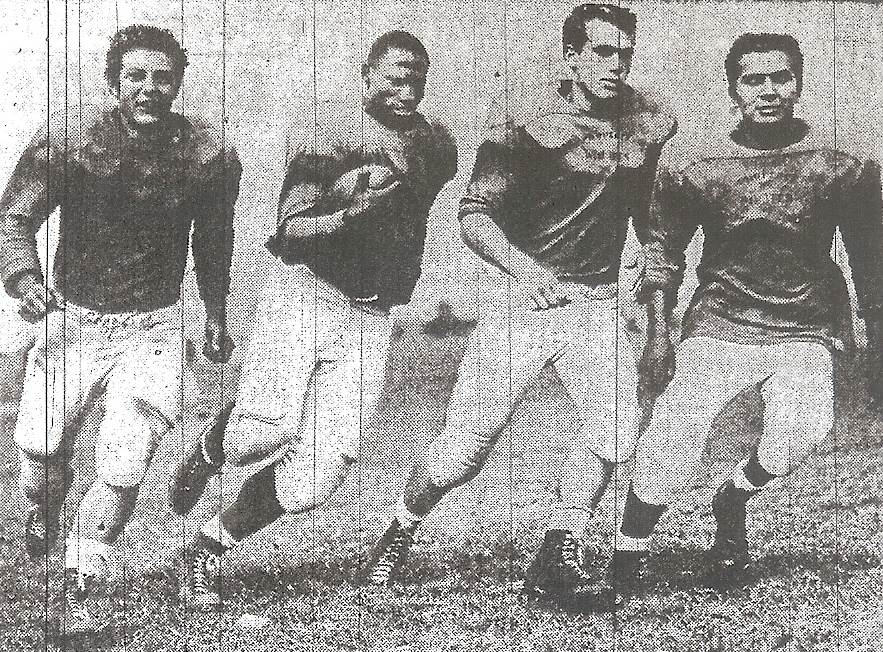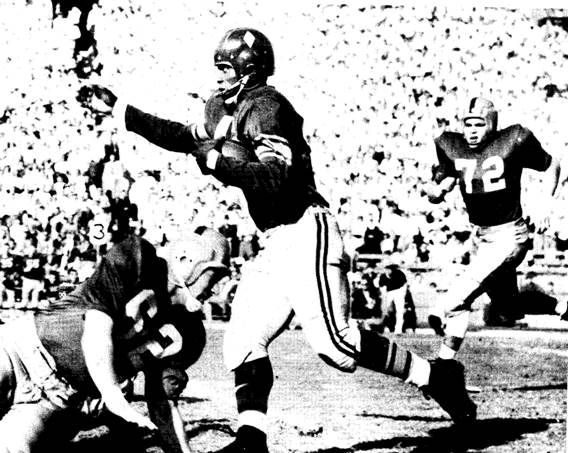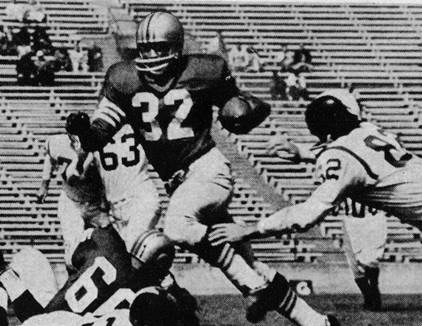

C.R. ROBERTS, FORGOTTEN HERO ON AND OFF THE FIELD
HELMET HUT NEWS/REFLECTIONS May 2015:
C.R. ROBERTS, FORGOTTEN HERO ON AND OFF THE FIELD
By Dr. Ken
Younger fans have no clue and older fans have no doubt forgotten the exploits and impact of C.R. Roberts, a former University Of Southern California running back who later played in the Canadian Football League and then with the San Francisco Forty Niners for four seasons. There are perhaps more football fanatics that are familiar with his high school exploits than his USC career and some who remember only his name as part of the Forty Niners “Alphabet Backfield.” Yet Cornelius R. Roberts was a force within every community he ever lived, creating positive change and the advancement of not only race related civil rights, but more accurately, the rights for all.
In what was a storied high school career, Roberts’ exploits have, after more than sixty years, still left him as the First Team Halfback on the San Diego Area All Time High School Football Team.
 |
Roberts was truly a man among boys as a two-way high school football star
Roberts scored thirty-one touchdowns in the first eight games of his 1952 junior season at Oceanside Carlsbad Union High School. At 180 pounds he had the power to run through and over opponents, and the track speed to run around them. With Ronnie Knox earning the Helms Athletic Foundation California High School Player Of The Year award, Roberts 1599 rushing yards, eleven yards per carry average, and 181 points scored found him as the California Small School Player Of The Year. “Robot” to his teammates because “all they had to do was request a touchdown and he’d produce one…” and “The Oceanside Express” to those in the press, he returned in ’53 for his senior season at 200 pounds and accumulated statistics that cemented his place on the “all time” lists and made him both a High School All American and again the California Player Of The Year. In nine games, rarely playing their full length, Roberts rushed for 1903 yards with games that included running totals of 274, 331, and 317 yards. He passed for seven touchdowns while ten of his thirty TD’s came from sixty to eighty-six yards in length. He scored 187 points and rushed for a 9.5 per carry average. Seemingly too good to be true, he excelled as a top rated track and field athlete, was the President of his Sunday School class, maintained a B academic average, and was an Eagle Scout. Looking first towards the United States Military Academy, Roberts instead opted to attend college locally at USC.
He continued his track and
field activities as a
sprinter and long jumper,
defeating future Olympian
Rafer Johnson with a 24
feet, 3.5 inch long jump.
Established as a punishing
fullback who augmented the
exciting runs of halfback
“Jaguar Jon” Arnett, Roberts
caught national attention in
the opening game of his 1956
junior season against Texas.
With but three
African-American players on
the Trojans squad, Roberts
was the most visible and he
was always quick to note
that while the USC general
student body may not have
been supportive to
minorities on campus, his
teammates and coaches were.
In the past when playing in
the South or Southwest where
racial segregation was the
rule or state law, most
integrated teams would leave
their African-American
players at home. As
President of his USC
fraternity, Roberts had
already integrated
fraternity row and had been
instrumental in getting the
USC Student Senate to
approve the presence of
females on what had always
been the USC all-male
cheerleading squad. He had
no intention of missing the
season’s opener despite
being in violation of Texas
state law and the very real
danger he would face.
 |
Neither university would agree to a cancellation of the game and from the perspective of Texas onlookers, the tension was ratcheted up when Roberts and his Black teammate stayed at a previously Whites-Only upscale hotel in Austin. Indicating that the experience in Alabama of USC’s Sam Cunningham which would follow a decade and a half later was really a sequel to his experience, Roberts later said, “I didn’t really get the picture” as his coaches tried to dissuade him from making the trip. “The coaches kept trying to tell me that the game was not that important. They tried to talk me out of traveling, saying we were going to win all the rest anyway.” He also clearly recalls intending to make a statement on the field, when given an opportunity. He noted “the greatest sense of satisfaction” he received when staying at the team hotel was having not only every African-American employee come to his room to congratulate him, but many residents from the city who would borrow one of the employee uniforms and sneak into the establishment, just to meet him and shake his hand. Roberts officially became the first African-American to participate in an athletic event against the University Of Texas within the state and although he played a scant twelve minutes, it was twelve minutes of pure hell for the Longhorns.
In those twelve minutes Roberts rushed for what became a long-standing school record of 251 yards and added three touchdowns to his personal beat down. It wasn’t until the opening game of the 1975 season that Ricky Bell eclipsed Roberts’ mark with a 256 yard performance against Duke. He put a tremendous hit on the Texas quarterback which very much incited the hostile and segregated crowd, bringing the staff’s decision to remove him from the game. The 44-20 victory kicked off a successful 8-2 season and his performance in the game made Roberts a national figure with All American mention. This event pushed him harder to correct what he believed were inequities and he returned to USC and was eventually successful in helping to gain approval for the first Black fraternity on the campus.
The entire 1956 season,
despite its success, was
unfortunately marred by the
scandal that affected the
major West Coast schools [
see HELMET HUT http://www.helmethut.com/College/USC/USC1956.html
]. With ambiguous rules
related to permissible
benefits and scholarship
eligibility, the entire
Pacific Coast Conference was
forced to reorganize by
1958. Many players, and
Roberts unfortunately one of
them, had to surrender up to
a year of eligibility.
Roberts chose to play what
would have been his senior
season at USC in the
Canadian Football League
instead, spending 1957 and
’58 with the Toronto
Argonauts. At the conclusion
of the ’58 collegiate season
when his USC graduating
class was eligible for the
National Football League
draft, he was a fourteenth
round pick of the New York
Giants. On July 8, 1959,
before his Giants career
began, Roberts was traded to
the Pittsburgh Steelers for
offensive guard Darrell Dess.
Steelers head coach Buddy
Parker was a prolific trader
and with bodies coming and
going, Roberts became
expendable and in
mid-September was released
and signed by the Forty
Niners prior to the season’s
final contest. He remained
with the Niners through the
1962 season, a contributor
at fullback rather than a
star in an offense loaded
with Pro Football Hall Of
Fame members Joe Perry, Hugh
McElhenny, and Y.A. Tittle,
J.D. Smith, R.C. Owens, John
Brodie, and before switching
to defense, the swift Abe
Woodson. One of Roberts
“best” contributions was his
inclusion in the 1960
backfield contingent that
gained the moniker “The
Alphabet Backfield” which
included Y.A. Tittle, R.C.
Owens, J.D. Smith, and
Roberts. At the conclusion
of the ’62 season, Roberts
returned to Canada and
played one more season with
the Hamilton Tiger Cats.

The end of his
professional
football career was
the true beginning
of his work that
contributed so much
to the communities
he lived and worked
in. All of the
ground breaking
efforts made at USC
were a prelude to a
lifetime of
improving the daily
existence of others.
He completed his
undergraduate degree
in Business
Administration from
USC and a Masters
Degree in
Educational
Administration from
Long Beach State; he
became the first
African-American
Loan Officer for
what was then a
segregated Bank Of
America; he
integrated the
Berkeley Board Of
Realtors; he was
instrumental in
securing housing
rights for
minorities in Los
Angeles. Roberts
spearheaded a drive
to incorporate the
city of Carson,
California and
became its first
Black mayor and then
was instrumental in
bringing the new
California State
University Dominguez
Hills campus to
Carson and making it
accessible for
moderate income
families. As the
holder of seven
teaching
certificates,
Roberts served as a
high school teacher
and administrator
for a number of
years. Perhaps
believing that he
was not doing
enough, he served as
the Transportation
Venue Assistant
Manager for the 1984
Olympic Games held
in and around Los
Angeles and as the
Vice President of
the Retired National
Football League
Players Association.
He has been chosen
to advise both
Congress and the
President’s office
on youth mentoring
and educational
projects and has
continued his work
in youth counseling
and with Christian
ministries. If this
seems to be an
ongoing and perhaps
never-ending list of
charitable and
community service
work, it almost is.
C.R. Roberts earned
a “name” as a
revered athlete and
then cashed it in
for the benefit of
his community. He
did this to an
extent that eclipsed
his time in the sun
as an athlete, for
the betterment of
many. As a
University Of
Southern California
alumnus, he is
revered by those at
USC for his work and
remains active in
all community and
university affairs.